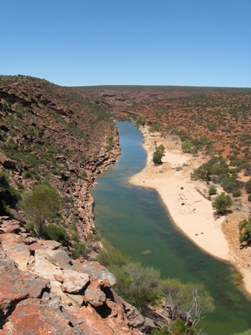 Ken McNamara* reports on fossil discoveries that are providing tantalising evidence of some of the first animals to live on land.
Ken McNamara* reports on fossil discoveries that are providing tantalising evidence of some of the first animals to live on land.
The world in which animals took their first tentative footsteps on land was a very different one from today. No verdant meadows, nor forests. Not a fern to be seen. The only plants were mosses and liverworts, clinging to rocks in wet places. For the most part the land was a bare, windswept world, probably not too dissimilar to the surface of Mars. Yet for some reason, some animals decided to leave the oceans, rivers and lakes, and venture on to this largely barren surface. Like the first Mars Rover that left its distinctive marks on virgin Martian soils, the first animals to drag themselves out of their aqueous world onto a harsh landscape at least 450 million years ago, left their own distinctive traces.
Image: Murchison River gorge at “The Loop”, Kalbarri National Park, Western Australia showing extensive outcrop of the Tumblagooda Sandstone. (All photos: Ken McNamara)
COLONISING
We are faced with a number of challenges to work out just when this happened, which organisms were involved, and the nature of the subsequently developed terrestrial ecosystems. The first is to determine whether a sandstone that has a beautifully preserved set of tracks arcing across it was deposited on land rather than under the sea or in a river. Secondly, evidence needs to be found to show that even though there may be sedimentological evidence for a terrestrial environment of deposition, the tracks were made by an animal walking out of water on land. To do this it is necessary to look at intricate details of each footfall, such as the little mounds of sand or sandsplashes left behind like miniature sandcastles to show that an animal once passed this way, with the sun on its back, rather than an aqueous cloak.
There are a number of candidates for the first animal to s tep onto land. Whether these intrepid creatures, boldly crawling where no creature had crawled before, formed part of a fledgling terrestrial ecosystem, or were just chance adventurers onto this alien landscape, is not clear. One proposal for the first colonisers are the animals that constructed millimetre-sized vertical burrows and centimetre-scale horizontal burrows in what have been interpreted as fluvial channels in the early Cambrian Wood Canyon Formation in California. However, doubts have been expressed as to the terrestrial nature of these sediments, some researchers preferring to regard them as having been deposited in a marginal marine setting. So, close maybe, but perhaps not close enough.
tep onto land. Whether these intrepid creatures, boldly crawling where no creature had crawled before, formed part of a fledgling terrestrial ecosystem, or were just chance adventurers onto this alien landscape, is not clear. One proposal for the first colonisers are the animals that constructed millimetre-sized vertical burrows and centimetre-scale horizontal burrows in what have been interpreted as fluvial channels in the early Cambrian Wood Canyon Formation in California. However, doubts have been expressed as to the terrestrial nature of these sediments, some researchers preferring to regard them as having been deposited in a marginal marine setting. So, close maybe, but perhaps not close enough.
Image: Diplichnites track made by unknown arthropod with about 8 pairs of legs walking across wet rippled sand surface.
More convincing are trackways made subaerially by arthropods in what have been interpreted as aeolian dunes in the Upper Cambrian to Lower Ordovician Nepean Formation in Ontario, Canada. Similarly, arthropod trackways in the late Ordovician Borrowdale Volcanic Group in the English Lake District appear to have been made on a wet, subaerial sand surface, suggesting periodic excursions by myriapod-like arthropods on to the land. The lack of other types of trace fossil, particularly burrows, in these sediments suggests that although these arthropods may have been making brief forays on to the land they were not part of any nascent terrestrial ecosystem.
Greg Retallack of the University of Oregon has argued that burrows found in the late Ordovician Juniata Formation in the eastern United States were made by millipedes, indicating the existence of one of the earliest terrestrial ecosystems. Others, though, have questioned this interpretation, citing both the lack of evidence that the burrows were even made by millipedes and the absence of plant material on which they are said to have fed. Moreover, the sediments could well be marine in origin.
DEPOSITING
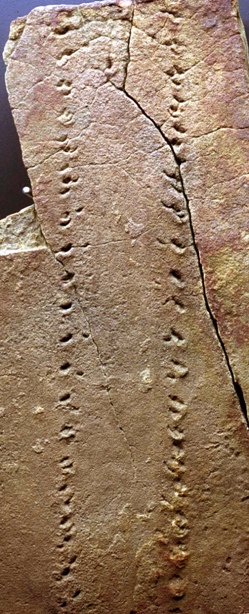 Image: Diplichnites track possibly made by eurypterid. Mounds of sand pushed up help indicate direction of travel and show that footprints made out of water on wet sand.
Image: Diplichnites track possibly made by eurypterid. Mounds of sand pushed up help indicate direction of travel and show that footprints made out of water on wet sand.
One indication of an established freshwater ecosystem is extensive bioturbation. The strongest contender for the title of the earliest known ecosystem of this type is the Tumblagooda Sandstone, Western Australia. This red-bed unit contains an extremely diverse trace-fossil fauna, rich in both burrows and trackways. It is best exposed in the deep gorge of the Murchison River in Kalbarri National Park, about 600km north of Perth. In outcrop it consists of over 1km of well-sorted, predominantly fluvial and aeolian sandstones that were deposited along the western margin of the Australian continent. Offshore the unit reaches up to 3.5km in thickness. The sands are thought to have been deposited sometime between the Ordovician and Silurian, although a Silurian age is more likely.
The sediments were probably generated by the uplift of the Australian continent to the southeast. Tumblagooda sediments contain abundant evidence for northwesterly fluvial flow. Uplift appears to have been occurring during early Silurian times, a conceivable depositional age for these sediments. Significantly, this was before the evolution of vascular plants, although ‘lower’ plants, like mosses and liverworts, would have been present. The evolution of vascular land plants is known to have had a major influence on styles of fluvial sedimentation. Before they appeared, river systems were predominantly braided, laterally expansive outflows. An extensive cover of vascular plants on land constrained water flow for the first time into well-defined channels, trapping finer, muddy fractions on alluvial floodplains. The nature of the Tumblagooda Sandstone sediments is consistent with deposition primarily under a braided stream regime.
Much of the early work on the sedimentology of the Tumblagooda Sandstone was carried out by Roger Hocking of the Geological Survey of Western Australia, followed by Nigel Trewin (University of Aberdeen) who worked both on sediments and trace fossils. Hocking showed that the sandstones form four discrete packages, reflecting different environments of deposition. The lowest, known as Facies Association (FA) 1 and the third, FA3, consist of massive units of trough cross-bedded sandstone thought to have been deposited under a braided fluvial regime. The uppermost unit, FA4, is generally thought to represent a more marginal marine environment of deposition, containing the vertical burrow Skolithos, which is usually indicative of marine deposition. It is the last sedimentary package, FA2, a unit dominated by thin-bedded sandstones, which contains the richest trace-fossil assemblage.
The sediments of FA2 consist mainly of sub-parallel sandsheets up to two metres thick, and thin low-angle cross-bedded units. Many of the sandsheets show distinctive aeolian features such as wind-ripple laminations. These deposits are thought to represent low sand-dunes whose intervening areas were periodically flooded, either by stream flow, or (more often than not) by a rising water-table. This environment of ephemeral water bodies forming, with little erosive water movement, in an environment where there was relatively little plant cover helped to pre serve a wide variety of trace fossils.
serve a wide variety of trace fossils.
TRACKING
Image: Eurypterid model (based on Mixopteris) showing typical characters of large, anterior claw-like appendages, and three pairs of walking appendages, the back pair being modified as paddles.
The most stunning of these are the great variety of tracks made by (probably) more than a dozen different types of arthropod, from eurypterids to euthycarcinoids, and myriapods to xiphosurids. Looking, on occasions, remarkably similar to the tracks left by Mars rovers, they range in size from about 5mm to 300mm across. The double sets of imprints show that these different arthropods possessed great variability in numbers of their walking legs. Some of the trackways are very extensive. The most impressive is a rippled bedding surface covering an area of about 8m by 5m, crossed by five trackways, each about 18cm across and running for many metres. Intriguingly, two of them come together and the discrete clusters of footprints lose their definition, making a shallow trench which suggests that perhaps one climbed on to the back of the other. After a few metres one staggers off to the side, while the other continues on. It is a matter of pure speculation as to the nature of this conjugal association…
One of the more frustrating aspects of studying the trackways is not being sure what made them. That it was arthropods of some sort seems beyond question; but unless the number of appendages that they used for walking can be ascertained and then fitted to a known organism, their identity remains enigmatic. Some of these beasts appear to have walked on three pairs of appendages, suggesting a eurypterid creator. Some sets of track have a central drag mark, either a pair of thin grooves or a much thicker single groove. Many lack a drag mark altogether. These tracks are called Diplichnites. Interestingly, eurypterids are known to have possessed a long, extruded genital appendage with a two-pronged termination, and it was probably this that dragged along the sediment, leaving a characteristic groove.
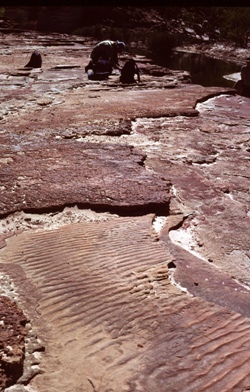 Image: Thinly bedded sands of the Tumblagooda Sandstone showing alternate thin rippled and heavily bioturbated beds.
Image: Thinly bedded sands of the Tumblagooda Sandstone showing alternate thin rippled and heavily bioturbated beds.
Other forms, possibly huge centipede-like myriapods called arthropleurids, up to a metre long, clearly walked on many more sets of legs. As the footfalls often coincided with imprints made by other appendages, unravelling the exact number of walking legs is a challenge. Fortunately, on occasions the animals either got bogged in the sand of perhaps were tacking into a stiff breeze, walking with a slightly skewed gait and repeated sets of footprints can be made out. Some forms seem to have had about eight sets of walking legs, and others 11!
HUNTING
The only body fossil ever found in the Tumblagooda Sandstone provides a clue to the identity of some of these track-makers. This is the fossilised remnant of an enigmatic euthycarcinoid arthropod called Kalbarria brimmellae. Until the discovery of this fossil the oldest known euthycarcinoid was Late Carboniferous. The discovery of Kalbarria in much older rocks pushed back the known range of these animals by at least 120 million years. Since then an even older, Cambrian, form has been found. Euthycarcinoids may be the ancestors of myriapods, crustaceans and insects.
Looking rather like a cockroach with 11 pairs of legs, Kalbarria has left behind not only evidence of what its body looked like, but also probably its trackways. Moreover, impressions of its body when it rested on the sand (a trace fossil called Rusophycus) are also preserved along with crescentic depressions where it stuck its head into the sand searching for food. These beds contain tiny holes that represent the openings of U-shaped burrows, probably occupied by the euthycarcinoids’ prey. This is one of a number of instances where we can see evidence of what appears to be one type of animal feeding on another - trophic levels which indicate that a complex and sophisticated ecosystem had developed on land at this time, quite early in the Silurian.
Other evidence of hunting comes from beds that are riddled with meandering vertical burrows, called Heimdallia. Looking for all the world like fossilised macaroni, these beds, up to 120mm thick, cover many square metres and represent places where shallow pools of water between dunes were occupied by small, burrowing arthropods mining the sand for food - probably algae or bacteria. Into this industrious world, large arthropods periodically swooped - scooping into the sand as they hunted for their prey, leaving behind shallow, near horizontal trenches, up to 30cm long.
Image: Bedding surface with extensive feeding trace Heimdallia, palimpsest ripples and the larger hunting burrow Tumblagoodichnus.
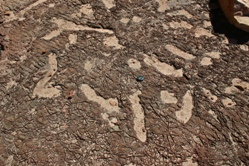
Further examples of feeding are seen on sloping surfaces that represent the bases of gently sloping dunes at the margins of these bodies of shallow water. As the water levels receded they left behind strand lines, which are often faithfully preserved, and many examples are known of tracks made by different types of arthropods walking parallel to these ephemeral shores, probably scavenging for stranded debris.
SANDCASTLES
The discovery of Kalbarria also provides some clues to how the trackways were preserved. The euthycarcinoid body fossil is preserved as an impression of the ventral surface of the animal, showing its legs and the underside of the plates that covered its thorax and abdomen. If you imagine squashing a cockroach on to a piece of plasticine, you would get the same sort of preservation. It seems likely that the animal was walking across a wet sand surface, was caught in a dust-storm and smothered by fine, dry sand. The minimal terrestrial vegetation cover at this time would have meant higher levels of erosion and high frequency of such transport of fine, dry sand.
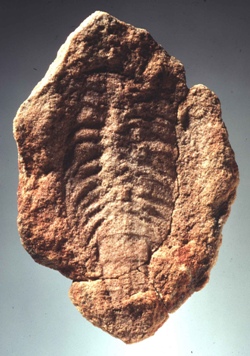 Image: The euthycarcinoid Kalbarria brimmelae. Specimen 13cm long.
Image: The euthycarcinoid Kalbarria brimmelae. Specimen 13cm long.
A similar scenario explains both the frequency with which trackways are preserved and supports the contention that they were made subaerially on wet sand surfaces. And this is where sandcastles come into the story. Research on wet granular piles (a.k.a. sandcastles) has shown that on wet sand surfaces that are subaerially exposed, surface tension between sand grains will provide a rigid, cohesive force over a wide range of water saturation. It is only in extremely wet or extremely dry sands that footprints will be ill-defined.
However in wet, cohesive sands each individual footprint can be preserved in exquisite detail, the walls of the footprints often being steep-sided to vertical because the wet sand was sufficiently cohesive when the foot was withdrawn from the sediment to retain its exact shape. The animal’s direction of movement can be interpreted from small, discrete mounds of sediment piled up behind each footprint - the first sandcastles. In one unusual set of footprints, finely preserved sand splashes have been produced by rapid flicking of the sediment during the animal’s locomotion stroke. These types of features can only be formed out of water, on wet sand surfaces. Animals were living on land.
LAND COLONISED
Most researchers consider that permanent terrestrial ecosystems did not appear on land until near the Silurian-Devonian boundary, which is about the time that vascular plants evolved and began to diversify. However the diverse burrows and trackways of the Tumblagooda Sandstone suggest that a structured, terrestrial ecosystem may have been in place by the early Silurian. The Tumblagooda Sandstone postdates the Cambrian explosion and the evolution of arthropods by up to 100 million years, so why did it take so long for animals to make this permanent transition from the oceans on to land? Perhaps it is all a question of scale. These early Palaeozoic trace fossils seem to reflect a world dominated by large arthropods, some more than a metre long, which colonised the land before it became smothered in plants.
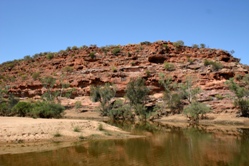 Image: Exposure of the mid Silurian Tumbalgooda Sandstone in the gorge of the Murchison River, Western Australia.
Image: Exposure of the mid Silurian Tumbalgooda Sandstone in the gorge of the Murchison River, Western Australia.
Intriguingly, a recent molecular study of mites has proposed a more complex scenario for terrestrial colonisation, with the suggestion that tiny oribatid mites (otherwise known as ‘moss mites’) possibly colonised land as early as the late Precambrian. The oldest fossil oribatids occur in late Devonian (376-379 Ma) rocks near Gilboa, New York. Perhaps, it has been suggested, terrestrialisation began with these very small, soil-dwelling mites. These tiny omnivorous and detritivorous arthropods, barely more than 1mm long and lurking between sand grains, would have facilitated the invasion of terrestrial habitats by later colonisers, acting as a ready food source for the larger arthropods that followed, in an arthropod-eat-arthropod world.
More research is clearly needed to unravel all the mysteries of this great event in evolutionary history, and to reveal just when the first footfall would have been distinctly heard.
* Ken McNamara is Director of the Sedgwick Museum, Department of Earth Sciences, University of Cambridge; email [email protected]
Further Reading
- Davies, N S & Gibling M R (2010) Cambrian to Devonian evolution of alluvial systems: the sedimentological impact of the earliest land plants. Earth-Science Reviews, v98, pp 171-200.
- Hocking R M (1991) The Silurian Tumblagooda Sandstone, Western Australia. Western Australia Geological Survey, Report 27.
- Trewin N H & McNamara K J (1995) Arthropods invade the land: trace fossils and palaeoenvironments of the Tumblagooda Sandstone (?late Silurian) of Kalbarri, Western Australia. Transactions of the Royal Society of Edinburgh, v85, pp 177–210.
- Schaefer, I, Norton, R A, Scheu, S & Maraun, M (2010) Arthropod colonization of land – Linking molecules and fossils in oribatid mites (Acari, Oribatida). Molecular Phylogenetics and Evolution, v57, pp 113-121.